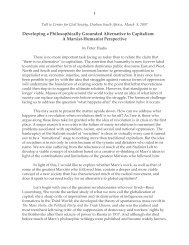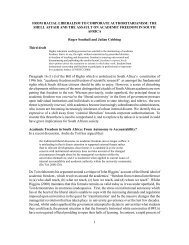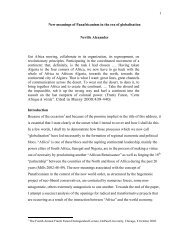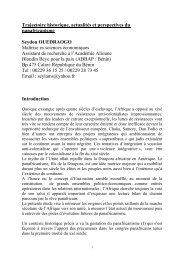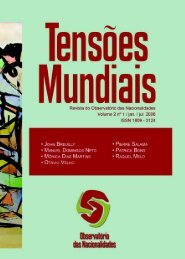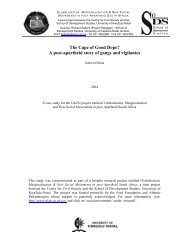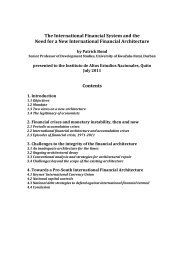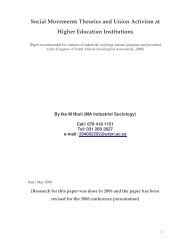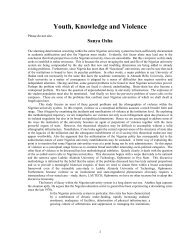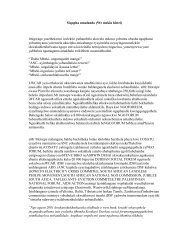April 2011 - Centre for Civil Society - University of KwaZulu-Natal
April 2011 - Centre for Civil Society - University of KwaZulu-Natal
April 2011 - Centre for Civil Society - University of KwaZulu-Natal
Create successful ePaper yourself
Turn your PDF publications into a flip-book with our unique Google optimized e-Paper software.
absence <strong>of</strong> any mass movement and by just a handful <strong>of</strong> votes. In two<br />
difficult years <strong>of</strong> life, the second government led by Romano Prodi, which<br />
the PRC (Party <strong>of</strong> Communist Refoundation) took part in worsening the<br />
already bad Italian welfare system, supported the military missions<br />
abroad, allowed the USA to double its military base in Vicenza (despite the<br />
strong opposition <strong>of</strong> the majority <strong>of</strong> the population), and carried out<br />
policies decidedly in favour <strong>of</strong> the bosses, putting <strong>of</strong>f carrying out the<br />
promises it had made to workers <strong>of</strong> a ‘second phase’ which never came.<br />
The disappointment that this caused amongst voters on the left was<br />
disastrous. In the following elections (<strong>April</strong> 2008), Berlusconi returned to<br />
power. The PD was roundly defeated. The two Left parties, PRC and PdCI<br />
(Italian Communists), disappeared from parliament. Abstentionism<br />
amongst workers and youth increased. Amongst the poorest sections <strong>of</strong> the<br />
population and in regions <strong>of</strong> the North, there was the beginning <strong>of</strong> a<br />
transfer <strong>of</strong> votes from the Left to the Lega Nord. Above all, the elections<br />
highlighted social passivity, workers’ isolation, the alienation <strong>of</strong> young<br />
people from politics and the crisis <strong>of</strong> the Left organisations.<br />
The role <strong>of</strong> the trade unions<br />
In all <strong>of</strong> these events the role played by the trade unions has been crucial.<br />
In the post-war period the three big trade union federations (CGIL, CISL,<br />
UIL) were the main link between political power and the working class.<br />
Closely linked <strong>for</strong> years with the Left and centre parties, and with millions<br />
<strong>of</strong> members, they exerted a fundamental influence on governments. In the<br />
‘hot autumn’ <strong>of</strong> 1969 they were enormously strengthened and a process <strong>of</strong><br />
trade union unification was begun. This only happened concretely amongst<br />
metal workers while the other three sectors <strong>of</strong> workers only went as far as<br />
a pact <strong>for</strong> united action.<br />
As the struggles ebbed and the first economic crisis took place (middle <strong>of</strong><br />
the 1970s) this union bloc was used by the bureaucracy to direct workers<br />
towards economic sacrifices and wage freezes. In brief, the compromise<br />
between trade unions and government was the following: CGIL, CISL, UIL<br />
would try to keep the workers in line and subjected to the demands <strong>of</strong><br />
capital, while in return they would be involved, together with<br />
Confindustria, in decisions concerning social issues.<br />
The end <strong>of</strong> the ‘first republic’ (following corruption scandals) and the<br />
beginning <strong>of</strong> Berlusconi’s reign destroyed this unwritten pact. The<br />
personality and populism <strong>of</strong> the new prime minister was not suited to long<br />
negotiations and mediation with ‘social partners’. Furthermore, the<br />
weakening <strong>of</strong> the workers’ movement in the previous period meant that<br />
the government could ignore symbolic and ever rare general strikes.<br />
This change put an end to unity <strong>of</strong> action between CGIL, CISL and UIL.<br />
While the latter two went down the road <strong>of</strong> increasingly worse<br />
compromises with the government and the bosses, in return <strong>for</strong> a few<br />
crumbs to feed the bureaucratic apparatus, the CGIL is proving incapable<br />
<strong>of</strong> deciding whether to go the same way as the other two or to try to<br />
represent, in what are certainly difficult conditions, the growing social<br />
unrest. The CGIL’s national congress which took place last year, did not<br />
resolve this dilemma and the discussion was mainly focused around<br />
internal organisational issues in an attempt to maintain a bureaucratic<br />
balance and isolate the FIOM (metal workers’ union, an autonomous<br />
category within the CGIL).<br />
A political alternative based on struggle<br />
In fact, today the FIOM is the only exception to a rather dismal trade union<br />
panorama. Depicted by the media as extremist and unrealistic, the FIOM is



